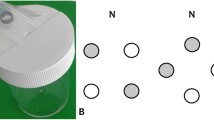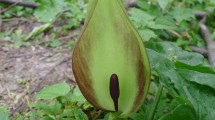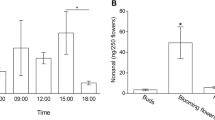Summary
Scent-marking of artificial food sources by workers of the bumblebee,Bombus terrestris, was investigated. Odour marks deposited on artificial flowers were subsequently collected and chemically analysed. Alkanes and alkenes were identified as the main components. The behaviour mediating capacity of synthetic mixtures of the identified compounds was bioassayed using an artificial flower system. A mixture of alkanes and alkenes, close to natural proportions, released regular foraging behaviour. The reaction proved to be dose-dependent.
Similar content being viewed by others
References
Blum MS (1981) Chemical Defenses of Arthropods. New York: Academic Press
Blum MS (1987) Specifity of pheromonal signals: a search for its recognitive bases in terms of a unified chemisociality. Pp 401–405in Eder J, Rembold H (eds) Chemistry and Biology of Social Insects. München: J Peperny
Brandsma L (1988) Preparative Acetylenic Chemistry. Amsterdam, Oxford, New York, Tokyo: Elsevier
Brian AD (1952) Division of labour and foraging inBombus agrorum Fabricius. J Anim Ecol 21:223–240
Brown CA, Vijay KA (1973) “P-2 Nickel” catalyst with ethylenediamine, a novel system for highly stereospecific reduction of alkynes to cis-olefines. J Chem Soc: 553–554
Cameron SA (1981) Chemical signals in bumblebee foraging. Behav Ecol Sociobiol 9:257–260
Carlson DA, Chin-Shyan R, Yost RA, Hector J (1989) Dimethyl disulfide derivates of long chain alkenes, alkadienes, and alkatrienes for gas chromatography/mass spectrometry. Anal Chem 61:1564–1571
Cruz-Landim C da, Staurengo MA (1965) Glande tarsale des Abeilles sans aiguillon. Proc V Int Cong IUSSI: Toulouse 219–225
Corbet SA, Kerslake CJC, Brown D, Morland NE (1984) Can bees select nectar rich flowers in a patch? J Apic Res 23:234–242
Ferguson AW, Free JB (1979) Production of a forage-marking pheromone by the honeybee. J Apic Res 18:128–135
Francis GW, Veland K (1981) Alkylthiolation for the determination of double-bond positions in linear alkenes. J Chromatogr 219:379–384
Francke W (1986) Convergency and diversity in multicomponent insect Pheromones. Pp 327–336in Parchet M, Audries JC, Dhainaut A (eds) Advances in Invertebrate Reproduction 4. Amsterdam, Oxford, New York, Tokyo: Elsevier
Frankie GW, Vinson SB (1977) Scent marking of passion flowers in Texas by females ofXylocopa virginica texana. J Kans Ent Soc 50:613–625
Frisch K von (1923) Über die “Sprache” der Bienen, eine tierpsychologische Untersuchung. Zool Jahrb Abt Allg Zool Physiol 40:1–186
Hagen E von (1986) Hummeln. Melsungen: Neumann-Neudamm Verlag
Heinrich B (1976) Resource partitioning among some eusocial insects: bumblebees. Ecology 57:874–889
Jacobs-Jessen UF (1959) Zur Orientierung der Hummeln und einiger anderer Hymenopteren. Z Vergl Physiol 41:597–641
Kato M (1988) Bumble bee visits toImpatiens spp.: Pattern and efficiency. Oecologia 76:364–370
Klimetzek D, Köhler J, Krohn S, Francke W (1989) Das Pheromon-System des Waldreben-BorkenkäfersXylocleptus bispinus Duft. (Col., Scolytidae). J appl Ent 107:304–309
Kullenberg B (1956) Field experiments with chemical sexual attractants on aculeate hymenopteran males. Zool Bidr Upps 31:253–280
Michener CD (1974) The Social Behavior of Bees. Cambridge/MA: Belknap
Nunez JA (1967) Sammelbienen markieren versiegte Futterquellen durch Duft. Naturwissenschaften 54:322–323
Schmitt U (1990) Hydrocarbons in tarsal-glands ofBombus terrestris. Experientia 46:1080–1082
Schmitt U, Bertsch A (1990) Do foraging bumblebees scent-mark food sources and does it matter? Oecologia 82:137–144
Sladen FWL (1902) A scent-producing organ in the abdomen of the worker ofApis mellifera. Ent Month Mag 38:208–211
Tengö J, Hefetz A, Bertsch A, Schmitt U, Lübke G, Francke W (1991) Species specifity and complexity of Dufour's gland secretion of bumble bees. Comp Biochem Physiol: in press
Wilhelm T, Pflumm W (1983) Über den Einfluβ blumenhafter Düfte auf das Duftmarkieren der Sammelbiene. Apidologie 14:183–190
Zöfel P (1988) Statistik in der Praxis. Stuttgart: Gustav-Fischer-Verlag
Author information
Authors and Affiliations
Rights and permissions
About this article
Cite this article
Schmitt, U., Lübke, G. & Francke, W. Tarsal secretion marks food sources in bumblebees (Hymenoptera: Apidae). Chemoecology 2, 35–40 (1991). https://doi.org/10.1007/BF01240664
Received:
Accepted:
Issue Date:
DOI: https://doi.org/10.1007/BF01240664




